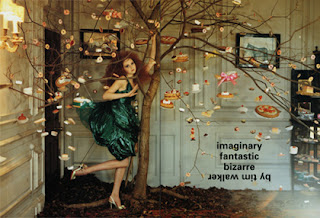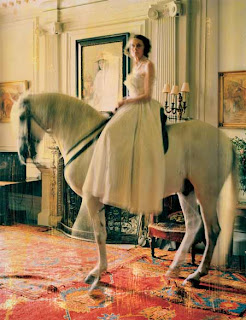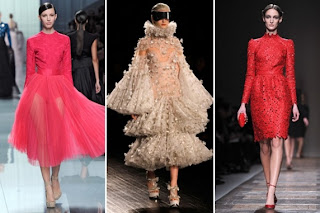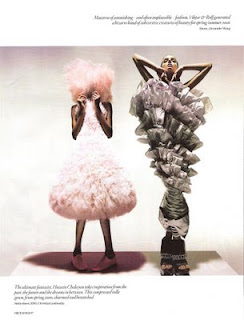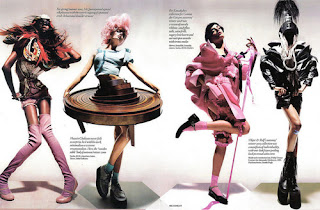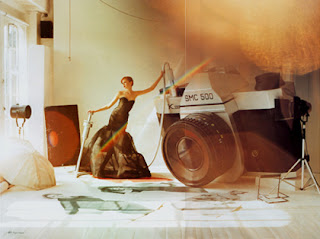Introduction
Throughout my essay I will be discussing Tim Walker, and the art movements of romanticism and surrealism. I will be focussing on how he implies and creates images of staged fantasy. And will uncover the fundamental motives and thoughts which lead Walker to expressing himself in such an eccentric and irrational style.
Bibliography
•Caws, M.A. (2004) Surrealism. London: Phaidon Press Ltd.
•Honour,H. (1979) Romanticism. London: Penguin Books Limited./
•Krauss,R. and Livingston, J. (1986) L’Amour fou: Photography and Surrealism.USA: Abbeville Press and the Corcoran Gallery of Art.
•Walker, T. (2008) Tim Walker Pictures. London: teNeues Publishing Group.
Caws, M.A. (2004) Surrealism. London: Phaidon Press Ltd.
- Surrealism is the first in an expanded range of Themes and Movements titles which look beyond the post-1945 period to survey all of the twentieth century's major art movements. Mary Ann Caws is an internationally respected scholar of Surrealism who has translated many of its major texts and published extensively on the Surrealists' art and writings
Honour,H. (1979) Romanticism. London: Penguin Books Limited.
- When reading the book it referred back to the literary and artistic movements of the late 18th and 19th cent.
Krauss,R. and Livingston, J. (1986) L’Amour fou: Photography and Surrealism.USA: Abbeville Press and the Corcoran Gallery of Art.
- ``the intensely illogical reality of a dream.'' British and American art educators Krauss, Livingston and Ades in this picture book examine the very extensive role of photography (an unlikely medium on the face of it) in the surrealist movement.
Walker, T. (2008) Tim Walker Pictures. London: teNeues Publishing Group.
I decided to mainly focus on Tim Walkers book titled `pictures` as it offered me a glimpse into the artistic process that he used. This comprehensive overview of his work brings us deep inside his glamorous world of adventure. Featuring a wide array of sketches, contacts and Polaroid's. The evocative images I think show a rich, textured nuance and intriguing detail. And also gave me a full rein to his playful side and intersperses collages among the photographs. Tim Walker's work appears in trend-setting magazines such as Vogue and W, and has also created advertising campaigns for exclusive clients such as Comme des Garcons. I was interested in his work form the begging of this term and couldn’t wait to start analysing his eccentric and irrational style of photography.
Biography
Tim Walker is a photographer based in London. He's interest in photography began during work experience at Condé Nast, where he set up the Cecil Beaton archive. After graduating from Exeter Art College, he worked as a freelance photographic assistant before working as Richard Avedon’s assistant in New York.
His career as a photographer was launched when he came third in the Independent Young Photographer of the Year Award. He then went on to contribute to high-profile magazines including Vogue, W and Harper‘s Bazaar. Throughout the years, Walker has also shot advertising campaigns for clients including Barneys, Comme des Garcons, Gap and Yohji Yamamoto.
FACTS…
•Tim" Walker (born in England, 1970) is a British fashion photographer.
Tim Walker’s photographs have appeared in Vogue, month by month, for over a decade. Extravagant staging and romantic motifs characterise his style. After concentrating on the photographic still for 15 years, Tim Walker has begun directing short films.
•
•
•
•
•
•
•
•
ROMANTICISM
Definitions of Romanticism became known during the early nineteenth century.
•When researching into romanticism, there’s no single work of art that signifies the aims and ideals of the Romantics for example, David’s Oath of the Horatii those of Neo-classical painters.
"Despite the lack of a concrete definition one can identify almost effortlessly the romantic soul behind Tim Walker's pictures”. Baudelaire said that, “Romanticism is precisely situated neither in choice of subject nor in exact truth, but in a way of feeling." (Honour, 1979:14)
•As an intern at Vogue in the early 1990s, Tim explored and studied the magazine’s of Cecil Beaton’s negatives. Research, Exposure to Vogue’s history, led to a lasting understanding of the British cultural history, specially the 30s, 40 and 50s, the era when Beaton flourished.
‘Through the heritage of Vogue, he has re-established tangible links to the romantic strain that marked out Norman Parkinson and Cecil Beaton as latter day Gainsboroughs and Zoffanys. He shares with them too a romantic “spirit of place”, most usually rural and paradisal, which is what Tim’s idea of a past England is.’ (Walker, 2008:8)
•Photographic history aside, Tim's narrative fashion stories portray bold colour, which refers back to the wartime films of Michael Powell and Emeric Pressburger and their own romantic attachment to the English landscape. But mostly, I think, they are obliged to refer back to the early 1940s and Britain's Neo-Romantic artists. “Often self-taught, their paintings are as earthy as if ploughed up from the land itself.” “(Walker, 2008:9)
Surrealism
•Surrealism is a cultural movement that began in the early 1920s.
•Surrealism in photography was one of the major revolutionary changes in the evolution of photography.
•Surrealism is the introduction of the ‘more than real' images to the art forms.
•surrealism was a break through in photography, which motivated the photographers for more experiments.
Surrealism was a movement in the art and intellectual activities, emerged after World War I.
•Andre Breton, was the founder of the surrealistic concepts and he has gathered the influence from the Dande movement.
•Surrealist photographs are described as the images, which symbolically represent dreams, night mares, intoxication, sexual ecstasy, hallucination and madness.
•
•The streak of surrealism in Tim's pictures is inescapable, informs Robin Muir, the photographic historian and former Picture Editor of British Vogue, in the introduction titled 'Paradise Regained' of the book Tim Walker Pictures.
Over emphasized props-drawing inspiration from surrealism art?
•His photo shoots remind me more of theatre sets.
•His staging and props are seen with immaculate detail, and texture.
•Everything he photographs is connected to his drawings of his childhood memories.
Tim Walker's Set Designer Talks the Fate of the Oversized Props —Set designer (and former Alexander McQueen art director) Simon Costin, who works with both Emma Summerton and Tim Walker, recently shared what happens to all the oversized props that have become a trademark in Walker's work: "It often breaks my heart to consign the props I create to the skip, but sadly, with them being so large, there is little alternative. When I work in NYC I can call Materials for the Arts and have things dropped off to them. Sadly London has yet to set something like that up. I’m pleased to say though, Tim has been able to store many things and has then displayed them at exhibitions of his work. The camera is one such prop."
•Robin Muir the photographic historian and former Picture Editor of British Vogue, explained in Tim Walkers Book `Pictures`, the chapter `Paradise Regained`,
“The streak of surrealism in Tim's pictures is inescapable. For example, you couldn't guess by the streaks of bacon ascending a model's legs chased by a spider crab or the torn sheets of paper out of which heads pop unexpectedly through.” (Walker, 2008:10) This denotes the British notion of surrealism which I think shines throughout his work.
•Surrealist paintings often exhibit many of the same traits: a deeply mysterious atmosphere, with unexplained elements that seem to refer to something else seen, read or imagined beyond the canvas:
“In a dusky urban setting with no human presence, where the scale and perspective of buildings, vistas and objects follows an unearthly logic, a single red glove is pinned to a wall, signalling something yet seeming as void as the gaze of a statue's head that floats beside it." (Caws, 2004:25)
•Take for instance his photo titled, `Boat in Library`….
Referring to this shoot, Paolo Lavezzari noted “Tim likes to clear out, recompose and confuse interiors and exteriors. In their paradox, in their careful exaggeration his pictures almost become a wish, an invitation to look with new eyes. There are no special effects to surprise us with because the wonder is in our eyes as we look for it ...” “(Walker, 2008:68) I agree with this quote as unlike film such as `Avatar`, Walker doesn’t need special effects to make his photo’s believable and inspiring, he uses imagination and creativity instead.
•I am very fascinated within this concept and use of inside/outdoor, creating a mixture of surrealism. Inside / outside is the notion of opposites attracting or repelling to create strange unusual landscapes both inside and, as here, out – of – doors.
When reading Tim Walkers book `pictures` I think the set designer Andy Hillman has explained it well: “You always return with a bump to the real world from Planet Walker and like a long haul flight, there is always some time needed to re – adjust. But you know you'll get the call: “I've got this idea...” "(Walker, 2008:162)
•As Aragon writes in Une Vague de reves:
“There are other relationships besides the real that the mind can grasp and which are just as primary, such as chance, illusion, the fantastic, the dream. These diverse species are united and reconciled in a genre which is Surrealism.” “(Caws, 2004:21)
'The dull colours of the real' are for the realistic and conscious minds. Perhaps that’s why during the art movement of Surrealism, Tim Walker likes to submerge into the subconscious and perhaps, overcome the logical and conscious mind.
•When researching I learnt, that the mysterious environment that you see in Surrealist imagery is not about creating, instead its how Tim Walker turns this abnormal environment into fun, which I believe gives the looker a sense of ease. Objects sit in unexpected places, which I assume interests the viewer, into making something believable yet impossible.
Take for instance his photo titled, `Boat in Library`….
Referring to this shoot, Paolo Lavezzari noted “Tim likes to clear out, recompose and confuse interiors and exteriors. In their paradox, in their careful exaggeration his pictures almost become a wish, an invitation to look with new eyes. There are no special effects to surprise us with because the wonder is in our eyes as we look for it ...” “(Walker, 2008:68) I agree with this quote as unlike film such as `Avatar`, Walker doesn’t need special effects to make his photo’s believable and inspiring, he uses imagination and creativity instead.
•`It Rained Outside So We Camped Inside' is another iconic and brilliant example of this theme, which I think resembles a certain Surrealist quality, referring to the weirdness of how characteristically altering objects are placed together to create the term of neighbours.
It was believed, Vogue was intrigued by Tim's jeu d’ esprit: “Maybe it is all about the photographer's fake game: to think and experiment. If the escape you wish for isn't feasible “outside”, you can organize it “inside” with a bit of imagination. That is where the adventure begins.” "(Walker, 2008:68)
•When reading Tim Walkers book `pictures` I think the set designer Andy Hillman has explained it well: “You always return with a bump to the real world from Planet Walker and like a long haul flight, there is always some time needed to re – adjust. But you know you'll get the call: “I've got this idea...” "(Walker, 2008:162)
This love of adventure and dreaming, has taken Tim back in time to his childhood storybooks.
Dream
• I also researched into Sigmund Freud’s theories and made me think, dream is, of course, frequently considered as the peak of the unconscious mind’s experience, and a resource for the conscious study of that experience. The numerous possibilities I think are never more exciting, to the Surrealists than in dream phenomena, whether interpreted collectively or individually. Far beyond the dull colours of the real, the Surrealists widen this unmanageable openness, as far as the mind could reach. Referring back to Tim Walker, I think he has established this concept throughout his work using creativity and never-endless originality.
As Aragon writes in Une Vague de reves:
“There are other relationships besides the real that the mind can grasp and which are just as primary, such as chance, illusion, the fantastic, the dream. These diverse species are united and reconciled in a genre which is Surrealism.” “(Caws, 2004:21)
• When viewing his work, I think Walker tries to create and shows us, what he sees in the way of dreams or in his sub- conscious mind. It is this innovation of the sub-conscious or unconscious, that remained a true passion for Beaton and the group of Surrealists.
FANTASY
•fantasy is a genre of fiction that commonly uses magic as an element of plot, theme or setting
•fantasy takes place in imaginary worlds where magic is common
•Fantasy includes fairy, tales, wizards, or witchcraft in events which avoid horror.
•Fantasy non-existent, it deals with the impossible.
•Dream-like stories, the reality of things is questionable? I could be real or could be delusion? E.g. Dorothy’s dream in the wizard of oz.
MAGIC
•Magic manipulates aspects of reality. It utilizes ways of understanding, experiencing and influencing the world.
•Magic id often viewed with suspicion.
SURRELAISM
•Surrealism shocks and rebukes the conventional notion’s of reality
•Surrealism questions – what is real and not?
•Surrealism uses sexuality portrayed by symbolism and the placing of objects, where they normally wouldn’t be!
•Surrealism magnifies the common perception
•Surrealism was the main influence in 20th century
•Erocyticism,socialism,dreams and the sub-consous and symbolism portrays surrealism.
TIM WLAKER FACTS
• Tim Walker telling stories through imaginary childhood memory
• His photos evoke wonder/our won capacity of dream
• He makes his photos look real, hard to believe fantasy isn’t!
Models being transformed into fairytale characters by the designs of costume.
Conclusion
I think, While some people may choose to approach life in the rational, logical manner; both the Surrealists and the Romantics lived by a dissimilar mind of thought. They both held responsibility for the reasonable thinking of the social and political conflict of their age, and responded by inventing a new, unreasonable thought, to create a new world.
Tim Walker approaches photography with a hint of silent upheaval, though not as significant as the rebellious nature of the Surrealists and Romantics. When society is affected, he makes the public dream of happier times through fantasy, imagination and through his childlike innocence. The child in him, shows through the image titled, “Running Away From Home”, and his use of childhood memory to create such fantasy narratives.










